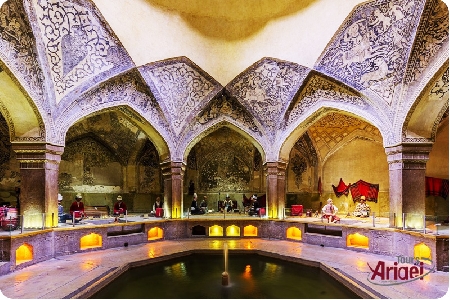Another genius architecture of Zand’s dynasty, neighboring two other works remained from the Zand era, Vakil mosque and Vakil bazaar. From the position of the thresholds and vestibules to the angel of slopes, everything in a Persian bath is chosen with deliberate consideration. The hierarchy of places helps reduce energy waste and stops the risk of particular diseases. The entrance to the bath is possible through a small door and usually curved staircases that lead to what in Farsi is referred to as “Hashti”, a vast area usually adorned with fascinating tile works and mosaics. This place, with its moderate weather, is used as a changing room, besides some festivities that require water like Henna-Bandan (part of wedding celebrations using water and henna before the actual ceremony) is held in this place. Some twisted vestibules lead to the “Garm Khane” or warm room. The vestibules have two functions, first, they balance the body temperature between Hashti’s and Garm Khaneh’s temperature, second with their narrow passage they stop energy waste. Then you turn to Garm Khane, here there are small empty channels under the floor attached to a kiln that spread warmth through the whole place. Garm Khane is where the whole bathing and washing takes place. At the end of the Garm Khane, there is the water room that is like a big cauldron filled with water used for bathing.
